General Information
Species Profiles
=================================
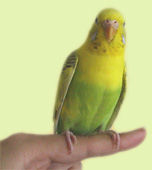 |
Budgies (aka Budgerigars) |
Personality: Budgies have a reputation to be friendly and easily tamed birds, making them the ideal canditate for family pets. They are inexpensive, easy to care for, less destructive to furnitures, and can be excellent talkers (but there is no guarantee). They can be very vocal and loud, especially when there is more than one Budgie. Budgies are known for being very curious birds and toys are required to keep them happy and active, whether they are living by themselves for in a flock.
Housing: Cages with 1/2 inch bar spacing and a dimension of 16"Wx12"Lx20"H is the minimum size for one budgie. Most commerical cages are often too small or designed poorly. Round cages, templed shaped cages, and domed/circular cages are not ideal for budgies. Square/rectangular cages make excellent cages.
Behavior Issues: Budgies can become jealous and possesive.
Medical Issues: Vitamin A deficiency, gout, scaly face (mites), goiter, obesity, and limpomas are the common problems faced by budgies.
Unusual Characteristics: Budgies are commonly called "parakeet", which is a generic name for a small parrot with a long tail. There is only one genus, however they have been bred to a larger size and come in 28 independent mutations (colors), all bred from the wild type green budgie. There are two general types of budgies: the American budgies (small) and the English budgies (almost 1.5x larger). Budgies are one of the few parrots that are sexually dimorphic (you are able to tell their sex via their cere color).
=================================
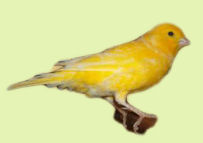 |
Canary Genus: Serinus Species: serinus Native Continent: Spain, Europe, Canary Islands. Lifespan: 7 - 15 years Adult size: 5 - 5.5 inches (12.5 - 14 cm) in length |
Personality: Canaries are serious loners. They do not like to be handled by humans very much. It takes a very long time, and incredible patience to tame one. Males are know to be the singers, and only rarely will a female sing. Canaries are easy to care for, are hardy birds, and are the ideal pets for first-time bird owners.
Housing: They are territorial birds, they need to be housed alone, and with the minimum housing size of 16"Lx16"Wx16"H with 1/2 inch bar spacing. Housing canaries alone will promote them to sing more. Canaries are more able to flying than climbing, and should never be given only one perch. Toys are not essential for canaries but they may enjoy swings and a small tub for bathing.
Behavior Issues: The one thing that comes up again and again with canaries is they are extremely territorial.
Medical Issues: Extremely sensitive respiratory system. Any trace gasses are dangerous to canaries.
Unusual Characteristics: There three general types of canaries: (1) song canaries (bred for their qualitiy of singing - German rollers, waterslagers, and American singers), (2)Color canaries (bred to produce new colors), and (3) type canaries (bred to obtain particular body shapes). Song canaries have softer voices whereas type and color canaries are louder and sound more shrill.
=============================
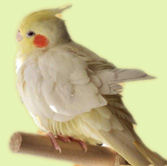 |
Cockatiel Genus: Nymphicus Species: hollandicus Native Continent: The interior sections of Australia. Lifespan: 18 - 25 years Adult size: 11-14 inchs in length |
Housing: The minimum housing for a cocktiel should be no less than 20"Lx20"Wx24"H with 3/4 inch bar spacing. Any smaller bar spacing tend to cause tears in the cockatiel's tail.
Behavior Issues: Cockatiels can often become upset at night, and thrash about in their cages (this is known as "Night Frights"). It's best to place a night light by their cage to prevent this.
Medical Issues: Cockatiels, like other bird, can become obese if they remain inactive. They have also been known to develop bacterial infections, yeast infections, fatty livers, and inbred kidney disease. Female cockatiels are known to lay eggs occasionally around the household (females do not need males to lay eggs). Because of this, they may be more susceptible to egg-binding problems and also calcium deficiency problems compared to other small birds.
Unusual Characteristics: There is one genus and one species of cockatiel, however, cocktiels are now bred in many different colors and patterns, which are called "mutations." Cockatiels have crests that are raised and lowered depending on the mood of the bird. They hiss when they are scared, putting their wings out and heads down in a defensive position. They also hang upside down like a bat, and flap their wings. Cockatiels can learn to talk (they do not have a good reputation to) but they are excellent at learning whistles.
===========================
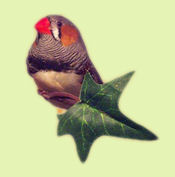 |
Finch |
Personality: The finch is a social bird, and will often be found sitting close to one another. They sing well, and most owners find them interesting to watch them interact with each other. Finches are cheerful, fast-moving, amusing and very active birds which also indicates that they are also very messy creatures. Finches often bite, but they do not hurt. They are the quietest type of little pet bird available, often making soft "meep meep" sounds. They are ideal for people living in small appartments.
Housing: Finches should be housed in pairs in a minimal cage size of 20L"x20"Wx20"H. They are extreme fliers, and should have multiple perches.
Behavior Issues: Finches can be aggressive to one another, and often attack the other especially housed in an aviary with nests. Finches are also prone to panic attacks.
Medical Issues: Egg binding, mites, over grown toenails and beaks, respiratory problems, constipation, and overcrossed bills.
Unusual Characteristics: A handfed finch can be taught to sit on top of a person's finger, fly to the person when called to, and some say can utter a couple of words (this is very rare). Finches are known be to extensive breeders - they litterally breed like rabbits! Put two finches of the opposite sex in a cage with a nest and you will end up with 15 finches in no time.
===========================
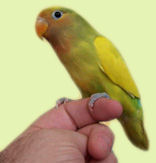 |
Love Bird Genus: Agapornis Species: roseicollis(peach face love bird), fischeri(fischer's love bird), and personata(masked lovebird) Native Continent: Africa Lifespan: 12 - 18 years Adult size: 5 to 6 inches in length |
Personality: The lovebird can be as feisty and headstrong as larger parrots, and love to play. They are vibant, very energtic, curious litle busy bodies. Hen are known to become very attached to their owners and become very aggressive, jealous, and territorial of "their human" towards other humans or other birds.
Housing: The lovebird should be in a cage sized no less than 18"Lx18"Wx18"H with 1/2 to 5/8 inch bar spacing. A rectangular cage is the best shape for lovebirds because they love to climb and fly horiztonally.
Behavior Issues: The lovebird can be territorial with it's cage, favorite toy, or person. They are very aggressive chewers and need to be supplied with chewing material (wood/hide/or leather straps) to chew on otherwise they can be very destructive to house furnitures.
Medical Issues: Lovebirds need lots of exercise, and plenty of toys to chew on.
===========================
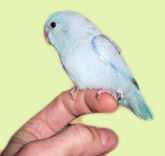 |
Parrotlet |
Personality: The parrotlet is an outgoing bird that bond quickly to their owners. They are capable of speech, and are practically fearless. They are feisty and demand attention very often from their owners. They need to be trained daily and at an early age otherwise they are known to become aggressive birds. The ideal canditate owners for parrolets should be people who are looking for a long-term companion and have time to spare. Parrotlets are known to be one of the most loyal birds as pets. They are surprisingly quiet birds, making them very ideal for people living in small appartments.
Housing: Minimum sized cages should be no less than 18"Lx18"Wx24"H with 1/2 inch bar spacing. They love swings and toys. Because they are feisty birds, they should never be housed together or even in separate cages that are side by side.
Behavior Issues: The parrotlet needs daily interaction, and can be aggressive as well as territorial to other birds and pets.
Medical Issues: Need a plentiful and healthy diet, because parrotlets are high energy birds. They are susceptible to a fungus called megabacteria which can be easily diagnosed, treated and cured.
